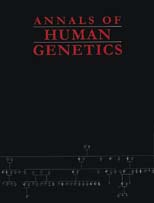Article contents
Evaluating linkage and linkage disequilibrium: use of excess sharing and transmission disequilibrium methods in affected sib pairs
Published online by Cambridge University Press: 04 January 2001
Abstract
Two popular and robust approaches to analysing affected sib pair (ASP) data for linkage are the traditional excess sharing methods and the transmission/disequilibrium test (TDT). Here we derive an overall test of linkage for multi-allelic ASP marker data which comprises two component tests: one for excess sharing and one for transmission disequilibrium. This method has several advantages. Firstly the overall test of linkage is often more powerful than either of the two component tests. Secondly the method makes it possible to determine the contribution of linkage disequilibrium (LD), in addition to linkage, to an overall positive linkage result. This is useful because the presence of LD in addition to linkage may suggest that the marker locus is in very close proximity to a disease susceptibility gene. Thirdly the method provides estimates of the risk associated with transmission of the different marker alleles.
- Type
- Research Article
- Information
- Copyright
- © University College London 2000
- 3
- Cited by


